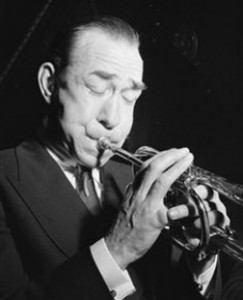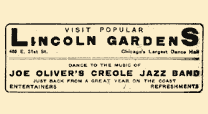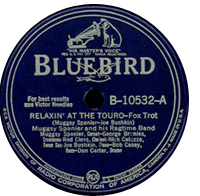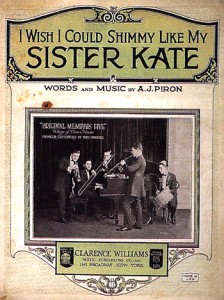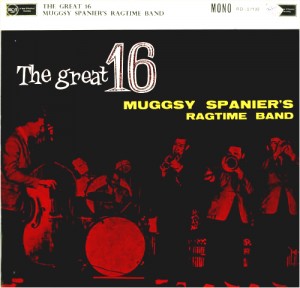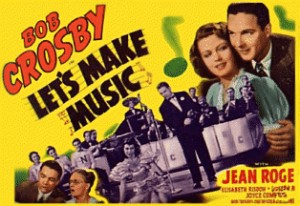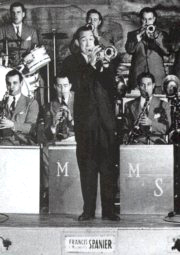Francis Joseph Julian Spanier was born in 1901 in Chicago. Like many kids he was crazy for baseball and yearned to be a professional ballplayer.
Spanier picked up the nickname 'Muggsy' because of his admiration for New York Giants team manager, John 'Muggsy' McGraw. Spanier said, "McGraw knew what he wanted, and he’d run right after it without considering the consequences. That’s the way I played (jazz), on impulse, without figuring out the ‘why’ or ‘what’…and I didn’t do so badly."
Hearing Joe 'King' Oliver at the Royal Gardens Cafe while he was still in grammar school turned Muggsy Spanier onto jazz. He never took lessons with Oliver, he just listened to his playing. He appreciated the way Oliver stuck close to the melody of a tune; the way he played few notes, mostly in the middle register, with good rhythm. He was a 'feeder,' helping the others in the band.
Alma Hubner wrote, "…Muggsy plays a truer, more Negroid, more authentic jazz style than any other contemporary white jazz cornetist. He’s based his style closely upon the pattern of Oliver’s, at the same time taking a lot from [Louis] Armstrong but never falling under the influence of [Bix] Beiderbecke."
Muggsy said, "I got to know Oliver quite well. Both he and Louis [Armstrong] encouraged me in my playing a lot. Joe sometimes would teach me some of his tricks with the mutes; I learned a lot from him. After a little practice I was invited to sit in with the band. I was the first one to do so…it must have seemed strange, a little kid blowing cornet with those two Titans! That’s one thrill I’ll never forget: having played with the two greatest cornetists in jazz!"
The other great influence on Spanier was the New Orleans Rhythm Kings, which he first heard in 1920 with New Orleanian George Brunies on trombone. Muggsy and Brunies became friends and associates for life.
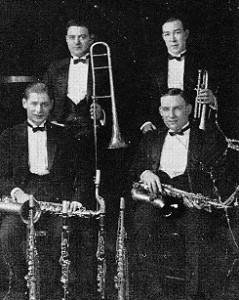
Muggsy Spanier (top right) with Sig Meyer Orchestra horn section, Chicago 1920. Photo by H. Opencer.
Bandleader Sig Meyer—for whom Muggsy worked early on—said, "Muggsy was fired with enthusiasm, a love of playing, and had that tremendous drive that gave the band he worked with an unbelievable lift."
Muggsy made his first record on February 25th, 1924 in Richmond, Indiana for the Gennett label. By 1928 Muggsy Spanier was well established in Chicago as a jazz player, both in person and on records. The next year Muggsy got his big break when Ted Lewis asked him to join his nationally popular orchestra. In 1935 the Ted Lewis band made the MGM film Here Comes the Band, in which Muggsy appears on screen.
Late in 1938 Spanier left Lewis and joined the Ben Pollack orchestra, replacing Harry James who was leaving to join Benny Goodman. During a tour of New Orleans he developed a perforated ulcer, a serious condition, and was hospitalized at the Touro Infirmary there. Muggsy made a slow and gradual recovery and after a year returned to Chicago and his music career.
In 1939 Muggsy said: "I'm trying to play the kind of music I used to play with Tesch [Frank Teschmacher] and the old Chicago gang. All the same, I wanted to be up-to-date too. I want to have the old Chicago in New Orleans tradition and yet be something contemporary and distinctive."
The result was the formation of Muggsy Spanier's Ragtime Band. The Band opened at the Sherman House Hotel in Chicago on April 28, 1939. Muggsy said, "We've only been together three weeks as my first job in 15 months. Doctors gave me up for lost after all those operations and I still can't understand how I survived. I could've gone back with Ted Lewis; only people were telling him I couldn't play anymore. That's why I got this little gang together just to show them I'm still around!"
The Ragtime Band was a big hit. Alma Hubner wrote, "Muggsy Spanier's Ragtime Band invaded the Sherman and established a new record by remaining there for five and a half months. The band had coast-to-coast radio hookups and the crowds at the Sherman Hotel went for it in a big way. It played good jazz, which was good listening or dancing, whichever way you were inclined. Bands like…Bunny Berrigan’s and Gene Krupa’s played opposite them, yet Muggsy’s boys always managed to steal the show. It wasn’t only Muggsy’s driving, inspired cornet that proved sensational to the general public opinion; it was the band as a whole as well. George Brunis and his tail-gate trombone plus his irrepressible flair for comedy gave the Ragtimers a solid basis for good showmanship. Rod Cless’ clarinet was inspired and inspiring. Then too, men like Pat Pattison, Bob Casey, George Zack, Joe Bushkin, Ray McKinstry, Nick Ciazza, Marty Greenberg, Don Carter and George Wettling added to the atmosphere of perfection."
In October of that year Muggsy and the Ragtime Band journeyed to New York to play at Nick's in Greenwich Village. But the engagement only lasted until December 10th. Muggsy Spanier's Ragtime Band lasted a mere seven months.
Before the band broke up they made 16 exceptional hot jazz records: 4 in Chicago and 12 in New York for the RCA Victor Bluebird label. When the first long-play collection of all the sessions was issued, it was entitled The Great 16, and this immediately became the generic name by which they are recognizable to all jazz buffs.
Spanier wrote, "People want to know why Victor didn't get me to record more of those Ragtime sides, for they were one of the biggest sellers. But they were not commercial stuff....So I imagine this answers the question."
After the breakup Muggsy recorded for Milt Gabler's Commodore Records and then joined the Bob Crosby orchestra in 1940. "One of my greatest thrills was playing with the Crosby band," Spanier told Alma Hubner. "I enjoyed myself immensely. Those boys had the right spirit. Jess [Stacey], Eddie Miller, Bobby Haggart, Nappy Lamare and Ray Bauduc certainly made something out of that band." During his time with the Crosby band Spanier appeared in two more films, Let's Make Music and Sis Hopkins.
Jim Cullum says, "During his touring days with the Bob Cats, whenever the band would find itself in a bar with a juke box, Muggsy would always play the Great 16 records."
Beginning in 1941 Muggsy formed his own big band. That year the band began a long engagement at the Arcadia ballroom in New York. The great New Orleans clarinet player Irving Fazola was one of the sidemen for a time. The band gained the No. 1 spot in the Melody Maker annual poll in Great Britain. The big band ceased to exist by September 1943. Exhausted, Muggsy returned to Chicago and then New York. By 1944 Muggsy was working with Eddie Condon and did more recording for Commodore.
In 1945 Muggsy placed seventh in the Down Beat yearly readers' poll, one place ahead of Dizzy Gillespie.
The post-war period found Muggsy constantly touring the US with small groups. He was frequently featured at Nick’s in Greenwich Village. Some of his sidemen were George Brunies, Darnell Howard, Truck Parham, Floyd Bean, Ralph Hutchinson, Barrett Deems and Riverwalk guests Bobby Gordon and Jack Maheu.
An offer to appear with Earl Hines at the Club Hangover in San Francisco prompted Muggsy to move there in 1957. He continued to lead and tour nationally until 1964 when he was featured at the Newport Jazz Festival. Muggsy died in 1967.
Note: Alma Hubner Interview with Muggsy Spanier first appeared in the April 1944 edition of the journal The Jazz Record, and is now collected in the book Selections from the Gutter, edited by Art Hodes and Chadwick Hansen.
Photo credit for Home Page: Marquee at State Lake Theatre. Image courtesy atomic-raygun.
Text based on Riverwalk Jazz script by Margaret Moos Pick ©2008


